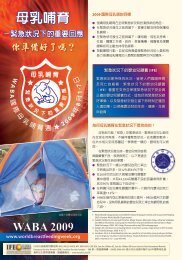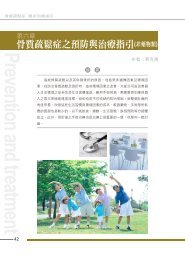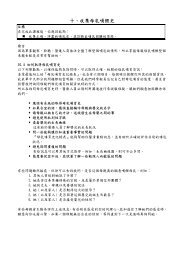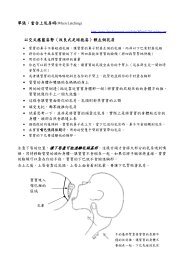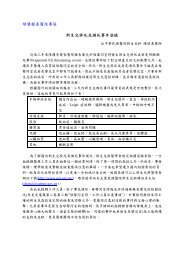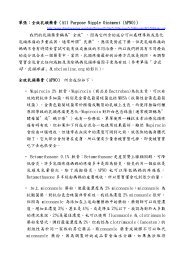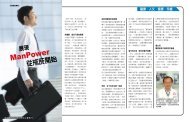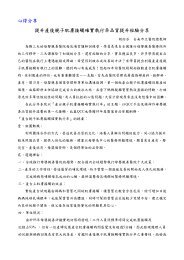WORLD HEALTH ORGANIZATION Infant and young child nutrition
WORLD HEALTH ORGANIZATION Infant and young child nutrition
WORLD HEALTH ORGANIZATION Infant and young child nutrition
You also want an ePaper? Increase the reach of your titles
YUMPU automatically turns print PDFs into web optimized ePapers that Google loves.
<strong>WORLD</strong> <strong>HEALTH</strong> <strong>ORGANIZATION</strong>FIFTY-FIFTH <strong>WORLD</strong> <strong>HEALTH</strong> ASSEMBLY A55/15Provisional agenda item 13.10 16 April 2002<strong>Infant</strong> <strong>and</strong> <strong>young</strong> <strong>child</strong> <strong>nutrition</strong>Global strategy on infant <strong>and</strong> <strong>young</strong> <strong>child</strong> feedingReport by the Secretariat1. The Executive Board, at its 101st session in January 1998, called for a revitalization of theglobal commitment to appropriate infant <strong>and</strong> <strong>young</strong> <strong>child</strong> <strong>nutrition</strong>, <strong>and</strong> in particular breastfeeding <strong>and</strong>complementary feeding. 1 Subsequently, in close collaboration with UNICEF, WHO organized aconsultation (Geneva, 13-17 March 2000) to assess infant <strong>and</strong> <strong>young</strong> <strong>child</strong> feeding policies, reviewkey interventions, <strong>and</strong> formulate a comprehensive strategy for the next decade.2. Following discussions at the Fifty-third World Health Assembly in May 2000 <strong>and</strong> the 107thsession of the Executive Board in January 2001 of the outline <strong>and</strong> critical issues of the globalstrategy, 2,3 the Fifty-fourth World Health Assembly reviewed progress 4 <strong>and</strong> requested the Director-General to submit the strategy to the Executive Board at its 109th session <strong>and</strong> to the Fifty-fifth WorldHealth Assembly, respectively in January <strong>and</strong> May 2002. 53. During their discussion of the draft global strategy, members of the Executive Boardcommended the setting in motion of the consultative, science-based process that had led to itsformulation as a guide for developing country-specific approaches to improving feeding practices.They also welcomed the strategy’s integrated <strong>and</strong> comprehensive approach. Several members madesuggestions with regard to the exact wording of the draft strategy. 6 These suggestions have been takencarefully into account in preparing the present draft (see annex), as have comments from MemberStates following the Board’s 109th session 7 <strong>and</strong> observations of other interested parties, includingprofessional associations, nongovernmental organizations <strong>and</strong> the processed-food industry. Stressingthe validity of a well-structured draft, the Executive Board recommended that the Health Assembly1 Document EB101/1998/REC/2.2 Decision WHA53(10).3 Document RC/2000/NUT.4 Document A54/7.5 Resolution WHA54.2, paragraph 3(6).6 See document EB109/2002/REC/2, summary records of the sixth, seventh <strong>and</strong> ninth meetings.7 Provided in response to circular letter C.L.5.2002, dated 8 February 2002.
Annex A55/15DETERMINING THE AIM AND OBJECTIVES6. The aim of this strategy is to improve – through optimal feeding – the <strong>nutrition</strong>al status, growth<strong>and</strong> development, health, <strong>and</strong> thus the survival of infants <strong>and</strong> <strong>young</strong> <strong>child</strong>ren.7. The strategy’s specific objectives are:• to raise awareness of the main problems affecting infant <strong>and</strong> <strong>young</strong> <strong>child</strong> feeding, identifyapproaches to their solution, <strong>and</strong> provide a framework of essential interventions;• to increase the commitment of governments, international organizations <strong>and</strong> other concernedparties 1 for optimal feeding practices for infants <strong>and</strong> <strong>young</strong> <strong>child</strong>ren;• to create an environment that will enable mothers, families <strong>and</strong> other caregivers in allcircumstances to make – <strong>and</strong> implement – informed choices about optimal feeding practicesfor infants <strong>and</strong> <strong>young</strong> <strong>child</strong>ren.8. The strategy is intended as a guide for action; it is based on accumulated evidence of thesignificance of the early months <strong>and</strong> years of life for <strong>child</strong> growth <strong>and</strong> development <strong>and</strong> it identifiesinterventions with a proven positive impact during this period. Moreover to remain dynamic,successful strategy implementation will rely on keeping pace with developments, while new clinical<strong>and</strong> population-based research is stimulated <strong>and</strong> behavioural concerns are investigated.9. No single intervention or group can succeed in meeting the challenge; implementing thestrategy thus calls for increased political will, public investment, awareness among health workers,involvement of families <strong>and</strong> communities, <strong>and</strong> collaboration between governments, internationalorganizations <strong>and</strong> other concerned parties that will ultimately ensure that all necessary action is taken.PROMOTING APPROPRIATE FEEDING FOR INFANTS AND YOUNG CHILDREN10. Breastfeeding is an unequalled way of providing ideal food for the healthy growth <strong>and</strong>development of infants; it is also an integral part of the reproductive process with importantimplications for the health of mothers. As a global public health recommendation, infants should beexclusively breastfed for the first six months of life to achieve optimal growth, development <strong>and</strong>health. 2 Thereafter, to meet their evolving <strong>nutrition</strong>al requirements, infants should receive <strong>nutrition</strong>allyadequate <strong>and</strong> safe complementary foods while breastfeeding continues for up to two years of age orbeyond. Exclusive breastfeeding from birth is possible except for a few medical conditions, <strong>and</strong>unrestricted exclusive breastfeeding results in ample milk production.11. Even though it is a natural act, breastfeeding is also a learned behaviour. Virtually all motherscan breastfeed provided they have accurate information, <strong>and</strong> support within their families <strong>and</strong>1 For the purposes of this strategy, other concerned parties include professional bodies, training institutions, industrial<strong>and</strong> commercial enterprises <strong>and</strong> their associations, nongovernmental organizations whether or not formally registered,religious <strong>and</strong> charitable organizations <strong>and</strong> citizens’ associations such as community-based breastfeeding support networks<strong>and</strong> consumer groups.2 As formulated in the conclusions <strong>and</strong> recommendations of the expert consultation (Geneva, 28-30 March 2001) thatcompleted the systematic review of the optimal duration of exclusive breastfeeding (see document A54/INF.DOC./4). Seealso resolution WHA54.2.5
A55/15 Annexcommunities <strong>and</strong> from the health care system. They should also have access to skilled practical helpfrom, for example, trained health workers, lay <strong>and</strong> peer counsellors, <strong>and</strong> certified lactation consultants,who can help to build mothers’ confidence, improve feeding technique, <strong>and</strong> prevent or resolvebreastfeeding problems.12. Women in paid employment can be helped to continue breastfeeding by being provided withminimum enabling conditions, for example paid maternity leave, part-time work arrangements, on-sitecrèches, facilities for expressing <strong>and</strong> storing breast milk, <strong>and</strong> breastfeeding breaks (see paragraph 27).13. <strong>Infant</strong>s are particularly vulnerable during the transition period when complementary feedingbegins. Ensuring that their <strong>nutrition</strong>al needs are met thus requires that complementary foods be:• timely – meaning that they are introduced when the need for energy <strong>and</strong> nutrients exceedswhat can be provided through exclusive <strong>and</strong> frequent breastfeeding;• adequate – meaning that they provide sufficient energy, protein <strong>and</strong> micronutrients to meet agrowing <strong>child</strong>’s <strong>nutrition</strong>al needs;• safe – meaning that they are hygienically stored <strong>and</strong> prepared, <strong>and</strong> fed with clean h<strong>and</strong>s usingclean utensils <strong>and</strong> not bottles <strong>and</strong> teats;• properly fed – meaning that they are given consistent with a <strong>child</strong>’s signals of appetite <strong>and</strong>satiety, <strong>and</strong> that meal frequency <strong>and</strong> feeding method – actively encouraging the <strong>child</strong>, evenduring illness to consume sufficient food using fingers, spoon or self-feeding – are suitablefor age.14. Appropriate complementary feeding depends on accurate information <strong>and</strong> skilled support fromthe family, community <strong>and</strong> health care system. Inadequate knowledge about appropriate foods <strong>and</strong>feeding practices is often a greater determinant of mal<strong>nutrition</strong> than the lack of food. Moreover,diversified approaches are required to ensure access to foods that will adequately meet energy <strong>and</strong>nutrient needs of growing <strong>child</strong>ren, for example use of home- <strong>and</strong> community-based technologies toenhance nutrient density, bioavailability <strong>and</strong> the micronutrient content of local foods.15. Providing sound <strong>and</strong> culture-specific <strong>nutrition</strong> counselling to mothers of <strong>young</strong> <strong>child</strong>ren <strong>and</strong>recommending the widest possible use of indigenous foodstuffs will help ensure that local foods areprepared <strong>and</strong> fed safely in the home. The agriculture sector has a particularly important role to play inensuring that suitable foods for use in complementary feeding are produced, readily available <strong>and</strong>affordable.16. In addition, low-cost complementary foods, prepared with locally available ingredients usingsuitable small-scale production technologies in community settings, can help to meet the <strong>nutrition</strong>alneeds of older infants <strong>and</strong> <strong>young</strong> <strong>child</strong>ren. Industrially processed complementary foods also provide anoption for some mothers who have the means to buy them <strong>and</strong> the knowledge <strong>and</strong> facilities to prepare<strong>and</strong> feed them safely. Processed-food products for infants <strong>and</strong> <strong>young</strong> <strong>child</strong>ren should, when sold orotherwise distributed, meet applicable st<strong>and</strong>ards recommended by the Codex AlimentariusCommission <strong>and</strong> also the Codex Code of Hygienic Practice for Foods for <strong>Infant</strong>s <strong>and</strong> Children.17. Food fortification <strong>and</strong> universal or targeted nutrient supplementation may also help to ensurethat older infants <strong>and</strong> <strong>young</strong> <strong>child</strong>ren receive adequate amounts of micronutrients.6
Annex A55/15EXERCISING OTHER FEEDING OPTIONS18. The vast majority of mothers can <strong>and</strong> should breastfeed, just as the vast majority of infants can<strong>and</strong> should be breastfed. Only under exceptional circumstances can a mother’s milk be consideredunsuitable for her infant. For those few health situations where infants cannot, or should not, bebreastfed, the choice of the best alternative – expressed breast milk from an infant’s own mother,breast milk from a healthy wet-nurse or a human-milk bank, or a breast-milk substitute fed with a cup,which is a safer method than a feeding bottle <strong>and</strong> teat – depends on individual circumstances.19. For infants who do not receive breast milk, feeding with a suitable breast-milk substitute – forexample an infant formula prepared in accordance with applicable Codex Alimentarius st<strong>and</strong>ards, or ahome-prepared formula with micronutrient supplements – should be demonstrated only by healthworkers, or other community workers if necessary, <strong>and</strong> only to the mothers <strong>and</strong> other family memberswho need to use it; <strong>and</strong> the information given should include adequate instructions for appropriatepreparation <strong>and</strong> the health hazards of inappropriate preparation <strong>and</strong> use. <strong>Infant</strong>s who are not breastfed,for whatever reason, should receive special attention from the health <strong>and</strong> social welfare system sincethey constitute a risk group.FEEDING IN EXCEPTIONALLY DIFFICULT CIRCUMSTANCES20. Families in difficult situations require special attention <strong>and</strong> practical support to be able to feedtheir <strong>child</strong>ren adequately. In such cases the likelihood of not breastfeeding increases, as do the dangersof artificial feeding <strong>and</strong> inappropriate complementary feeding. Wherever possible, mothers <strong>and</strong> babiesshould remain together <strong>and</strong> be provided the support they need to exercise the most appropriate feedingoption under the circumstances.21. <strong>Infant</strong>s <strong>and</strong> <strong>young</strong> <strong>child</strong>ren who are malnourished are most often found in environments whereimproving the quality <strong>and</strong> quantity of food intake is particularly problematic. To prevent a recurrence<strong>and</strong> to overcome the effects of chronic mal<strong>nutrition</strong>, these <strong>child</strong>ren need extra attention both during theearly rehabilitation phase <strong>and</strong> over the longer term. Nutritionally adequate <strong>and</strong> safe complementaryfoods may be particularly difficult to obtain <strong>and</strong> dietary supplements may be required for these<strong>child</strong>ren. Continued frequent breastfeeding <strong>and</strong>, when necessary, relactation are important preventivesteps since mal<strong>nutrition</strong> often has its origin in inadequate or disrupted breastfeeding.22. The proportion of infants with low birth weight varies from 6% to more than 28% depending onthe setting. Most are born at or near term <strong>and</strong> can breastfeed within the first hour after birth. Breastmilk is particularly important for preterm infants <strong>and</strong> the small proportion of term infants with verylow birth weight; they are at increased risk of infection, long-term ill-health <strong>and</strong> death.23. <strong>Infant</strong>s <strong>and</strong> <strong>child</strong>ren are among the most vulnerable victims of natural or human-inducedemergencies. Interrupted breastfeeding <strong>and</strong> inappropriate complementary feeding heighten the risk ofmal<strong>nutrition</strong>, illness <strong>and</strong> mortality. Uncontrolled distribution of breast-milk substitutes, for example inrefugee settings, can lead to early <strong>and</strong> unnecessary cessation of breastfeeding. For the vast majority ofinfants emphasis should be on protecting, promoting <strong>and</strong> supporting breastfeeding <strong>and</strong> ensuringtimely, safe <strong>and</strong> appropriate complementary feeding. There will always be a small number of infantswho have to be fed on breast-milk substitutes. Suitable substitutes, procured, distributed <strong>and</strong> fed safelyas part of the regular inventory of foods <strong>and</strong> medicines, should be provided.7
A55/15 Annex24. An estimated 1.6 million <strong>child</strong>ren are born to HIV-infected women each year, mainly in lowincomecountries. The absolute risk of HIV transmission through breastfeeding for more than oneyear – globally between 10% <strong>and</strong> 20% – needs to be balanced against the increased risk of morbidity<strong>and</strong> mortality when infants are not breastfed. All HIV-infected mothers should receive counselling,which includes provision of general information about meeting their own <strong>nutrition</strong>al requirements <strong>and</strong>about the risks <strong>and</strong> benefits of various feeding options, <strong>and</strong> specific guidance in selecting the optionmost likely to be suitable for their situation. Adequate replacement feeding is needed for infants bornto HIV-positive mothers who choose not to breastfeed. It requires a suitable breast-milk substitute, forexample an infant formula prepared in accordance with applicable Codex Alimentarius st<strong>and</strong>ards, or ahome-prepared formula with micronutrient supplements. Heat-treated breast milk, or breast milkprovided by an HIV-negative donor mother, may be an option in some cases. To reduce the risk ofinterfering with the promotion of breastfeeding for the great majority, providing a breast-milksubstitute for these infants should be consistent with the principles <strong>and</strong> aim of the International Codeof Marketing of Breast-milk Substitutes (see paragraph 19). For mothers who test negative for HIV, orwho are untested, exclusive breastfeeding remains the recommended feeding option (seeparagraph 10).25. Children living in special circumstances also require extra attention – for example, orphans <strong>and</strong><strong>child</strong>ren in foster care, <strong>and</strong> <strong>child</strong>ren born to adolescent mothers, mothers suffering from physical ormental disabilities, drug- or alcohol-dependence, or mothers who are imprisoned or part ofdisadvantaged or otherwise marginalized populations.IMPROVING FEEDING PRACTICES26. Mothers, fathers <strong>and</strong> other caregivers should have access to objective, consistent <strong>and</strong> completeinformation about appropriate feeding practices, free from commercial influence. In particular, theyneed to know about the recommended period of exclusive <strong>and</strong> continued breastfeeding; the timing ofthe introduction of complementary foods; what types of food to give, how much <strong>and</strong> how often; <strong>and</strong>how to feed these foods safely.27. Mothers should have access to skilled support to help them initiate <strong>and</strong> sustain appropriatefeeding practices, <strong>and</strong> to prevent difficulties <strong>and</strong> overcome them when they occur. Knowledgeablehealth workers are well placed to provide this support, which should be a routine part not only ofregular prenatal, delivery <strong>and</strong> postnatal care but also of services provided for the well baby <strong>and</strong> sick<strong>child</strong>. Community-based networks offering mother-to-mother support, <strong>and</strong> trained breastfeedingcounsellors working within, or closely with, the health care system, also have an important role to playin this regard. Where fathers are concerned, research shows that breastfeeding is enhanced by thesupport <strong>and</strong> companionship they provide as family providers <strong>and</strong> caregivers.28. Mothers should also be able to continue breastfeeding <strong>and</strong> caring for their <strong>child</strong>ren after theyreturn to paid employment. This can be accomplished by implementing maternity protectionlegislation <strong>and</strong> related measures consistent with ILO Maternity Protection Convention, 2000 No. 183<strong>and</strong> Maternity Protection Recommendation, 2000 No. 191. Maternity leave, day-care facilities <strong>and</strong>paid breastfeeding breaks should be available for all women employed outside the home.29. Continuing clinical <strong>and</strong> population-based research <strong>and</strong> investigation of behavioural concernsare essential ingredients for improving feeding practices. Crucial areas include completion <strong>and</strong>application of the new international growth reference, prevention <strong>and</strong> control of micronutrientmal<strong>nutrition</strong>, programmatic approaches <strong>and</strong> community-based interventions for improving8
Annex A55/15breastfeeding <strong>and</strong> complementary feeding practices, improving maternal <strong>nutrition</strong>al status <strong>and</strong>pregnancy outcome, <strong>and</strong> interventions for preventing mother-to-<strong>child</strong> transmission of HIV in relationto infant feeding.ACHIEVING THE STRATEGY’S OBJECTIVES30. A first step to achieving the objectives of this strategy is to reaffirm the relevance – indeed theurgency – of the four operational targets of the Innocenti Declaration on the Protection, Promotion <strong>and</strong>Support of Breastfeeding: 1• appointing a national breastfeeding coordinator with appropriate authority, <strong>and</strong> establishing amultisectoral national breastfeeding committee composed of representatives from relevantgovernment departments, nongovernmental organizations, <strong>and</strong> health professionalassociations;• ensuring that every facility providing maternity services fully practices all the “Ten steps tosuccessful breastfeeding” set out in the WHO/UNICEF statement on breastfeeding <strong>and</strong>maternity services; 2• giving effect to the principles <strong>and</strong> aim of the International Code of Marketing of Breast-milkSubstitutes <strong>and</strong> subsequent relevant Health Assembly resolutions in their entirety;• enacting imaginative legislation protecting the breastfeeding rights of working women <strong>and</strong>establishing means for its enforcement.31. Many governments have taken important steps towards realizing these targets <strong>and</strong> much hasbeen achieved as a result, notably through the Baby-friendly Hospital Initiative <strong>and</strong> the legislation <strong>and</strong>other measures that have been adopted with regard to the marketing of breast-milk substitutes.Achievements are far from uniform, however, <strong>and</strong> there are signs of weakened commitment, forexample in the face of the HIV/AIDS p<strong>and</strong>emic <strong>and</strong> the number <strong>and</strong> gravity of complex emergenciesaffecting infants <strong>and</strong> <strong>young</strong> <strong>child</strong>ren. Moreover, the Innocenti Declaration focuses uniquely onbreastfeeding. Thus, additional targets are needed to reflect a comprehensive approach to meeting care<strong>and</strong> feeding requirements during the first three years of life through a wide range of interrelatedactions.32. In the light of accumulated scientific evidence, <strong>and</strong> policy <strong>and</strong> programme experience, the timeis right for governments, with the support of international organizations <strong>and</strong> other concerned parties:• to reconsider how best to ensure the appropriate feeding of infants <strong>and</strong> <strong>young</strong> <strong>child</strong>ren <strong>and</strong> torenew their collective commitment to meeting this challenge;1 Meeting in Florence in July 1990, government policy-makers from more than 30 countries adopted the InnocentiDeclaration. The Forty-fourth World Health Assembly, in 1991, welcomed the Declaration as “a basis for international healthpolicy <strong>and</strong> action” <strong>and</strong> requested the Director-General to monitor achievement of its targets (resolution WHA44.33).2 Protecting, promoting <strong>and</strong> supporting breastfeeding: the special role of maternity services. A joint WHO/UNICEFstatement, Geneva, WHO, 1989.9
A55/15 Annex• to constitute effective broad-based bodies to lead the implementation of this strategy as acoordinated multisectoral national response by all concerned parties to the multiple challengesof infant <strong>and</strong> <strong>young</strong> <strong>child</strong> feeding; 1 <strong>and</strong>• to establish a system to monitor regularly feeding practices, assess trends using sexdisaggregateddata <strong>and</strong> evaluate the impact of interventions.33. With these considerations in mind, the global strategy includes as a priority for all governmentsthe achievement of the following additional operational targets: 2• to develop, implement, monitor <strong>and</strong> evaluate a comprehensive policy on infant <strong>and</strong> <strong>young</strong><strong>child</strong> feeding, in the context of national policies <strong>and</strong> programmes for <strong>nutrition</strong>, <strong>child</strong> <strong>and</strong>reproductive health, <strong>and</strong> poverty reduction;• to ensure that the health <strong>and</strong> other relevant sectors protect, promote <strong>and</strong> support exclusivebreastfeeding for six months <strong>and</strong> continued breastfeeding up to two years of age or beyond,while providing women access to the support they require – in the family, community <strong>and</strong>workplace – to achieve this goal;• to promote timely, adequate, safe <strong>and</strong> appropriate complementary feeding with continuedbreastfeeding;• to provide guidance on feeding infants <strong>and</strong> <strong>young</strong> <strong>child</strong>ren in exceptionally difficultcircumstances, <strong>and</strong> on the related support required by mothers, families <strong>and</strong> other caregivers;• to consider what new legislation or other suitable measures may be required, as part of acomprehensive policy on infant <strong>and</strong> <strong>young</strong> <strong>child</strong> feeding, to give effect to the principles <strong>and</strong>aim of the International Code of Marketing of Breast-milk Substitutes <strong>and</strong> to subsequentrelevant Health Assembly resolutions.IMPLEMENTING HIGH-PRIORITY ACTION34. A comprehensive national policy, based on a thorough needs assessment, should foster anenvironment that protects, promotes <strong>and</strong> supports appropriate infant <strong>and</strong> <strong>young</strong> <strong>child</strong> feeding practices.An effective feeding policy consistent with efforts to promote overall household food security requiresthe following critical interventions:For protection• adopting <strong>and</strong> monitoring application of a policy of maternity entitlements, consistent with theILO Maternity Protection Convention <strong>and</strong> Recommendation, in order to facilitatebreastfeeding by women in paid employment, including those whom the st<strong>and</strong>ards describe as1 Consistent with the first target of the Innocenti Declaration, more than 100 countries have already appointed anational breastfeeding coordinator <strong>and</strong> established a multisectoral national committee. These arrangements could form thebasis for the creation of the new body called for here.2 Governments should set a realistic date for achievement of all the global strategy’s targets <strong>and</strong> define measurableindicators to assess their progress in this regard.10
Annex A55/15engaging in atypical forms of dependent work, for example part-time, domestic <strong>and</strong>intermittent employment;• ensuring that processed complementary foods are marketed for use at an appropriate age, <strong>and</strong>that they are safe, culturally acceptable, affordable <strong>and</strong> <strong>nutrition</strong>ally adequate, in accordancewith relevant Codex Alimentarius st<strong>and</strong>ards;• implementing <strong>and</strong> monitoring existing measures to give effect to the International Code ofMarketing of Breast-milk Substitutes <strong>and</strong> to subsequent relevant Health Assemblyresolutions, <strong>and</strong>, where appropriate, strengthening them or adopting new measures;For promotion• ensuring that all who are responsible for communicating with the general public, includingeducational <strong>and</strong> media authorities, provide accurate <strong>and</strong> complete information aboutappropriate infant <strong>and</strong> <strong>young</strong> <strong>child</strong> feeding practices, taking into account prevailing social,cultural <strong>and</strong> environmental circumstances;For support through the health care system• providing skilled counselling <strong>and</strong> help for infant <strong>and</strong> <strong>young</strong> <strong>child</strong> feeding, for instance at wellbabyclinics, during immunization sessions, <strong>and</strong> in in- <strong>and</strong> out-patient services for sick<strong>child</strong>ren, <strong>nutrition</strong> services, <strong>and</strong> reproductive health <strong>and</strong> maternity services;• ensuring that hospital routines <strong>and</strong> procedures remain fully supportive of the successfulinitiation <strong>and</strong> establishment of breastfeeding through implementation of the Baby-friendlyHospital Initiative, monitoring <strong>and</strong> reassessing already designated facilities, <strong>and</strong> exp<strong>and</strong>ingthe Initiative to include clinics, health centres <strong>and</strong> paediatric hospitals;• increasing access to antenatal care <strong>and</strong> education about breastfeeding, to delivery practiceswhich support breastfeeding <strong>and</strong> to follow-up care which help to ensure continuedbreastfeeding;• promoting good <strong>nutrition</strong> for pregnant <strong>and</strong> lactating women;• monitoring the growth <strong>and</strong> development of infants <strong>and</strong> <strong>young</strong> <strong>child</strong>ren as a routine <strong>nutrition</strong>intervention, with particular attention to low-birth-weight <strong>and</strong> sick infants <strong>and</strong> those born toHIV-positive mothers, <strong>and</strong> ensuring that mothers <strong>and</strong> families receive appropriatecounselling;• providing guidance on appropriate complementary feeding with emphasis on the use ofsuitable locally available foods which are prepared <strong>and</strong> fed safely;• promoting adequate intake of essential nutrients through access to suitable – includingfortified – local foods <strong>and</strong>, when necessary, micronutrient supplements;• enabling mothers to remain with their hospitalized <strong>child</strong>ren to ensure continued breastfeeding<strong>and</strong> adequate complementary feeding <strong>and</strong>, where feasible, allow breastfed <strong>child</strong>ren to staywith their hospitalized mothers;11
A55/15 Annex• ensuring effective therapeutic feeding of sick <strong>and</strong> malnourished <strong>child</strong>ren, including theprovision of skilled breastfeeding support when required;• training health workers who care for mothers, <strong>child</strong>ren <strong>and</strong> families with regard to:– counselling <strong>and</strong> assistance skills needed for breastfeeding, complementary feeding,HIV <strong>and</strong> infant feeding <strong>and</strong>, when necessary, feeding with a breast-milk substitute,– feeding during illness,– health workers’ responsibilities under the International Code of Marketing of BreastmilkSubstitutes;• revising <strong>and</strong> reforming pre-service curricula for all health workers, <strong>nutrition</strong>ists <strong>and</strong> alliedprofessionals to provide appropriate information <strong>and</strong> advice on infant <strong>and</strong> <strong>young</strong> <strong>child</strong> feedingfor use by families <strong>and</strong> those involved in the field of infant <strong>and</strong> <strong>young</strong> <strong>child</strong> <strong>nutrition</strong>;For support in the community• promoting development of community-based support networks to help ensure appropriateinfant <strong>and</strong> <strong>young</strong> <strong>child</strong> feeding, for example mother-to-mother support groups <strong>and</strong> peer or laycounsellors, to which hospitals <strong>and</strong> clinics can refer mothers on discharge;• ensuring that community-based support networks not only are welcome within the health caresystem but also participate actively in the planning <strong>and</strong> provision of services;For support for feeding infants <strong>and</strong> <strong>young</strong> <strong>child</strong>ren in exceptionally difficult circumstances• ensuring that health workers have accurate <strong>and</strong> up-to-date information about infant feedingpolicies <strong>and</strong> practices, <strong>and</strong> that they have the specific knowledge <strong>and</strong> skills required tosupport caregivers <strong>and</strong> <strong>child</strong>ren in all aspects of infant <strong>and</strong> <strong>young</strong> <strong>child</strong> feeding inexceptionally difficult circumstances;• creating conditions that will facilitate exclusive breastfeeding, by provision, for example, ofappropriate maternity care, extra food rations <strong>and</strong> drinking-water for pregnant <strong>and</strong> lactatingwomen, <strong>and</strong> staff who have breastfeeding counselling skills;• ensuring that suitable – preferably locally available – complementary foods are selected <strong>and</strong>fed, consistent with the age <strong>and</strong> <strong>nutrition</strong>al needs of older infants <strong>and</strong> <strong>young</strong> <strong>child</strong>ren;• searching actively for malnourished infants <strong>and</strong> <strong>young</strong> <strong>child</strong>ren so that their condition can beidentified <strong>and</strong> treated, they can be appropriately fed, <strong>and</strong> their caregivers can be supported;• giving guidance for identifying infants who have to be fed on breast-milk substitutes,ensuring that a suitable substitute is provided <strong>and</strong> fed safely for as long as needed by theinfants concerned, <strong>and</strong> preventing any “spillover effect” of artificial feeding into the generalpopulation;• ensuring that health workers with knowledge <strong>and</strong> experience in all aspects of breastfeeding<strong>and</strong> replacement feeding are available to counsel HIV-positive women;12
Annex A55/15• adapting the Baby-friendly Hospital Initiative by taking account of HIV/AIDS <strong>and</strong> byensuring that those responsible for emergency preparedness are well trained to supportappropriate feeding practices consistent with the Initiative’s universal principles;• ensuring that whenever breast-milk substitutes are required for social or medical reasons, forexample for orphans or in the case of HIV-positive mothers, they are provided for as long asthe infants concerned need them.OBLIGATIONS AND RESPONSIBILITIES35. Governments, international organizations <strong>and</strong> other concerned parties share responsibility forensuring the fulfilment of the right of <strong>child</strong>ren to the highest attainable st<strong>and</strong>ard of health <strong>and</strong> the rightof women to full <strong>and</strong> unbiased information, <strong>and</strong> adequate health care <strong>and</strong> <strong>nutrition</strong>. Each partnershould acknowledge <strong>and</strong> embrace its responsibilities for improving the feeding of infants <strong>and</strong> <strong>young</strong><strong>child</strong>ren <strong>and</strong> for mobilizing required resources. All partners should work together to achieve fully thisstrategy’s aim <strong>and</strong> objectives, including by forming fully transparent innovative alliances <strong>and</strong>partnerships consistent with accepted principles for avoiding conflict of interest.Governments36. The primary obligation of governments is to formulate, implement, monitor <strong>and</strong> evaluate acomprehensive national policy on infant <strong>and</strong> <strong>young</strong> <strong>child</strong> feeding. In addition to political commitmentat the highest level, a successful policy depends on effective national coordination to ensure fullcollaboration of all concerned government agencies, international organizations <strong>and</strong> other concernedparties. This implies continual collection <strong>and</strong> evaluation of relevant information on feeding policies<strong>and</strong> practices. Regional <strong>and</strong> local governments also have an important role to play in implementingthis strategy.37. A detailed action plan should accompany the comprehensive policy, including defined goals<strong>and</strong> objectives, a timeline for their achievement, allocation of responsibilities for the plan’simplementation <strong>and</strong> measurable indicators for its monitoring <strong>and</strong> evaluation. For this purpose,governments should seek, when appropriate, the cooperation of appropriate international organizations<strong>and</strong> other agencies, including global <strong>and</strong> regional lending institutions. The plan should be compatiblewith, <strong>and</strong> form an integral part of, all other activities designed to contribute to optimal infant <strong>and</strong><strong>young</strong> <strong>child</strong> <strong>nutrition</strong>.38. Adequate resources – human, financial <strong>and</strong> organizational – will have to be identified <strong>and</strong>allocated to ensure the plan’s timely successful implementation. Constructive dialogue <strong>and</strong> activecollaboration with appropriate groups working for the protection, promotion <strong>and</strong> support ofappropriate feeding practices will be particularly important in this connection. Support forepidemiological <strong>and</strong> operational research is also a crucial component.Other concerned parties39. Identifying specific responsibilities within society – crucial complementary <strong>and</strong> mutuallyreinforcing roles – for protecting, promoting <strong>and</strong> supporting appropriate feeding practices is somethingof a new departure. Groups that have an important role in advocating the rights of women <strong>and</strong> <strong>child</strong>ren<strong>and</strong> in creating a supportive environment on their behalf can work singly, together <strong>and</strong> with13
A55/15 Annexgovernments <strong>and</strong> international organizations to improve the situation by helping to remove bothcultural <strong>and</strong> practical barriers to appropriate infant <strong>and</strong> <strong>young</strong> <strong>child</strong> feeding practices.Health professional bodies40. Health professional bodies, which include medical faculties, schools of public health, public <strong>and</strong>private institutions for training health workers (including midwives, nurses, <strong>nutrition</strong>ists <strong>and</strong>dietitians), <strong>and</strong> professional associations, should have the following main responsibilities towards theirstudents or membership:• ensuring that basic education <strong>and</strong> training for all health workers cover lactation physiology,exclusive <strong>and</strong> continued breastfeeding, complementary feeding, feeding in difficultcircumstances, meeting the <strong>nutrition</strong>al needs of infants who have to be fed on breast-milksubstitutes, <strong>and</strong> the International Code of Marketing of Breast-milk Substitutes <strong>and</strong> thelegislation <strong>and</strong> other measures adopted to give effect to it <strong>and</strong> to subsequent relevant HealthAssembly resolutions;• training in how to provide skilled support for exclusive <strong>and</strong> continued breastfeeding, <strong>and</strong>appropriate complementary feeding in all neonatal, paediatric, reproductive health, <strong>nutrition</strong>al<strong>and</strong> community health services;• promoting achievement <strong>and</strong> maintenance of “baby-friendly” status by maternity hospitals,wards <strong>and</strong> clinics, consistent with the “Ten steps to successful breastfeeding” 1 <strong>and</strong> theprinciple of not accepting free or low-cost supplies of breast-milk substitutes, feeding bottles<strong>and</strong> teats;• observing, in their entirety, their responsibilities under the International Code of Marketing ofBreast-milk Substitutes <strong>and</strong> subsequent relevant Health Assembly resolutions, <strong>and</strong> nationalmeasures adopted to give effect to both;• encouraging the establishment <strong>and</strong> recognition of community support groups <strong>and</strong> referringmothers to them.Nongovernmental organizations including community-based support groups41. The aims <strong>and</strong> objectives of a wide variety of nongovernmental organizations operating locally,nationally <strong>and</strong> internationally include promoting the adequate food <strong>and</strong> <strong>nutrition</strong> needs of <strong>young</strong><strong>child</strong>ren <strong>and</strong> families. For example, charitable <strong>and</strong> religious organizations, consumer associations,mother-to-mother support groups, family clubs, <strong>and</strong> <strong>child</strong>-care cooperatives all have multipleopportunities to contribute to the implementation of this strategy through, for example:• providing their members accurate, up-to-date information about infant <strong>and</strong> <strong>young</strong> <strong>child</strong>feeding;• integrating skilled support for infant <strong>and</strong> <strong>young</strong> <strong>child</strong> feeding in community-basedinterventions <strong>and</strong> ensuring effective linkages with the health care system;1 Protecting, promoting <strong>and</strong> supporting breastfeeding: the special role of maternity services. A joint WHO/UNICEFstatement, Geneva, WHO, 1989.14
Annex A55/15• contributing to the creation of mother- <strong>and</strong> <strong>child</strong>-friendly communities <strong>and</strong> workplaces thatroutinely support appropriate infant <strong>and</strong> <strong>young</strong> <strong>child</strong> feeding;• working for full implementation of the principles <strong>and</strong> aim of the International Code ofMarketing of Breast-milk Substitutes <strong>and</strong> subsequent relevant Health Assembly resolutions.42. Parents <strong>and</strong> other caregivers are most directly responsible for feeding <strong>child</strong>ren. Ever keen toensure that they have accurate information to make appropriate feeding choices, parents neverthelessare limited by their immediate environment. Since they may have only infrequent contact with thehealth care system during a <strong>child</strong>’s first two years of life, it is not unusual for caregivers to be moreinfluenced by community attitudes than by the advice of health workers.43. Additional sources of information <strong>and</strong> support are found in a variety of formal <strong>and</strong> informalgroups, including breastfeeding-support <strong>and</strong> <strong>child</strong>-care networks, clubs <strong>and</strong> religious associations.Community-based support, including that provided by other mothers, lay <strong>and</strong> peer breastfeedingcounsellors <strong>and</strong> certified lactation consultants, can effectively enable women to feed their <strong>child</strong>renappropriately. Most communities have self-help traditions that could readily serve as a base forbuilding or exp<strong>and</strong>ing suitable support systems to help families in this regard.Commercial enterprises44. Manufacturers <strong>and</strong> distributors of industrially processed foods intended for infants <strong>and</strong> <strong>young</strong><strong>child</strong>ren also have a constructive role to play in achieving the aim of this strategy. They should ensurethat processed food products for infants <strong>and</strong> <strong>child</strong>ren, when sold, meet applicable Codex Alimentariusst<strong>and</strong>ards <strong>and</strong> the Codex Code of Hygienic Practice for Foods for <strong>Infant</strong>s <strong>and</strong> Children. In addition, allmanufacturers <strong>and</strong> distributors of products within the scope of the International Code of Marketing ofBreast-milk Substitutes, including feeding bottles <strong>and</strong> teats, are responsible for monitoring theirmarketing practices according to the principles <strong>and</strong> aim of the Code. They should ensure that theirconduct at every level conforms to the Code, subsequent relevant Health Assembly resolutions, <strong>and</strong>national measures that have been adopted to give effect to both.The social partners45. Employers should ensure that maternity entitlements of all women in paid employment are met,including breastfeeding breaks or other workplace arrangements – for example facilities for expressing<strong>and</strong> storing breast milk for later feeding by a caregiver – in order to facilitate breast-milk feeding oncepaid maternity leave is over. Trade unions have a direct role in negotiating adequate maternityentitlements <strong>and</strong> security of employment for women of reproductive age (see paragraphs 28 <strong>and</strong> 34).Other groups46. Many other components of society have potentially influential roles in promoting good feedingpractices. These elements include:• education authorities, which help to shape the attitudes of <strong>child</strong>ren <strong>and</strong> adolescents aboutinfant <strong>and</strong> <strong>young</strong> <strong>child</strong> feeding – accurate information should be provided through schools<strong>and</strong> other educational channels to promote greater awareness <strong>and</strong> positive perceptions;• mass media, which influence popular attitudes towards parenting, <strong>child</strong> care <strong>and</strong> productswithin the scope of the International Code of Marketing of Breast-milk Substitutes – their15
A55/15 Annexinformation on the subject <strong>and</strong>, just as important, the way they portray parenting, <strong>child</strong>care<strong>and</strong> products should be accurate, up to date, objective, <strong>and</strong> consistent with the Code’sprinciples <strong>and</strong> aim;• <strong>child</strong>-care facilities, which permit working mothers to care for their infants <strong>and</strong> <strong>young</strong><strong>child</strong>ren, should support <strong>and</strong> facilitate continued breastfeeding <strong>and</strong> breast-milk feeding.International organizations47. International organizations, including global <strong>and</strong> regional lending institutions, should placeinfant <strong>and</strong> <strong>young</strong> <strong>child</strong> feeding high on the global public health agenda in recognition of its centralsignificance for realizing the rights of <strong>child</strong>ren <strong>and</strong> women; they should serve as advocates forincreased human, financial <strong>and</strong> institutional resources for the universal implementation of thisstrategy; <strong>and</strong>, to the extent possible, they should provide additional resources for this purpose.48. Specific contributions of international organizations to facilitate the work of governmentsinclude the following:Developing norms <strong>and</strong> st<strong>and</strong>ards• developing evidence-based guidelines to facilitate achievement of the strategy’s operationaltargets;• supporting epidemiological <strong>and</strong> operational research;• promoting the consistent use of common global indicators for monitoring <strong>and</strong> evaluating<strong>child</strong>-feeding trends;• developing new indicators, for example concerning adequate complementary feeding;• improving the quality <strong>and</strong> availability of sex-disaggregated global, regional <strong>and</strong> national data;Supporting national capacity-building• sensitizing <strong>and</strong> training health policy-makers <strong>and</strong> health service administrators;• improving health worker skills in support of optimal infant <strong>and</strong> <strong>young</strong> <strong>child</strong> feeding;• revising related pre-service curricula for doctors, nurses, midwives, <strong>nutrition</strong>ists, dietitians,auxiliary health workers <strong>and</strong> other groups as necessary;• planning <strong>and</strong> monitoring the Baby-friendly Hospital Initiative <strong>and</strong> exp<strong>and</strong>ing it beyond thematernity-care setting;• helping to ensure sufficient resources for this purpose, especially in highly indebted countries;16
Annex A55/15Supporting policy development <strong>and</strong> promotion• supporting social-mobilization activities, for example using the mass media to promoteappropriate infant feeding practices <strong>and</strong> educating media representatives;• advocating ratification of ILO Maternity Protection Convention 2000 No. 183 <strong>and</strong> applicationof Recommendation 2000 No. 191, including for women in atypical forms of dependentwork;• urging implementation of the International Code of Marketing of Breast-milk Substitutes <strong>and</strong>subsequent relevant Health Assembly resolutions, <strong>and</strong> providing related technical support onrequest;• ensuring that all Codex Alimentarius st<strong>and</strong>ards <strong>and</strong> related texts dealing with foods for infants<strong>and</strong> <strong>young</strong> <strong>child</strong>ren are consistent with WHO policy concerning appropriate marketing <strong>and</strong>distribution, recommended age of use, <strong>and</strong> safe preparation <strong>and</strong> feeding, including as reflectedin the International Code of Marketing of Breast-milk Substitutes <strong>and</strong> subsequent relevantHealth Assembly resolutions;• ensuring that the International Code of Marketing of Breast-milk Substitutes <strong>and</strong> subsequentrelevant Health Assembly resolutions are respected in trade policies <strong>and</strong> negotiations;• supporting research on marketing practices <strong>and</strong> the International Code.CONCLUSION49. This strategy describes essential interventions to protect, promote <strong>and</strong> support appropriate infant<strong>and</strong> <strong>young</strong> <strong>child</strong> feeding. It focuses on the importance of investing in this crucial area to ensure that<strong>child</strong>ren develop to their full potential, free from the adverse consequences of compromised <strong>nutrition</strong>alstatus <strong>and</strong> preventable illnesses. The strategy focuses on the roles of critical partners – governments,international organizations <strong>and</strong> other concerned parties – <strong>and</strong> assigns specific responsibilities for eachto ensure that the sum of their collective action will contribute to the full attainment of the strategy’saim <strong>and</strong> objectives. It builds on existing approaches, extended where necessary, <strong>and</strong> provides aframework for linking synergistically the contributions of multiple programme areas, including<strong>nutrition</strong>, <strong>child</strong> health <strong>and</strong> development, <strong>and</strong> maternal <strong>and</strong> reproductive health. The strategy now needsto be translated into action.50. There is convincing evidence from around the world that governments, with the support of theinternational community <strong>and</strong> other concerned parties, are taking seriously their commitments toprotect <strong>and</strong> promote the health <strong>and</strong> <strong>nutrition</strong>al well-being of infants, <strong>young</strong> <strong>child</strong>ren, <strong>and</strong> pregnant <strong>and</strong>lactating women. 1 One of the enduring tangible results of the International Conference on Nutrition,namely the World Declaration on Nutrition, offers a challenging vision of a world transformed.Meanwhile, its Plan of Action for Nutrition charts a credible course for achieving this transformation. 21 Document A55/14.1992.2 World Declaration <strong>and</strong> Plan of Action for Nutrition. International Conference on Nutrition, Rome, FAO <strong>and</strong> WHO,17
A55/15 Annex51. In the decade since its adoption, 159 Member States (83%) have demonstrated theirdetermination to act by preparing or strengthening their national <strong>nutrition</strong> policies <strong>and</strong> plans. Morethan half (59%) have included specific strategies to improve infant <strong>and</strong> <strong>young</strong> <strong>child</strong> feeding practices.This encouraging result needs to be consolidated, <strong>and</strong> exp<strong>and</strong>ed to include all Member States, even asit is reviewed <strong>and</strong> updated to ensure that it takes full account of the present comprehensive agenda.Clearly, however, much more is required if the aim <strong>and</strong> objectives of this strategy – <strong>and</strong> present <strong>and</strong>future feeding challenges – are to be met.52. This global strategy provides governments <strong>and</strong> society’s other main agents with both a valuableopportunity <strong>and</strong> a practical instrument for rededicating themselves, individually <strong>and</strong> collectively, toprotecting, promoting <strong>and</strong> supporting safe <strong>and</strong> adequate feeding for infants <strong>and</strong> <strong>young</strong> <strong>child</strong>reneverywhere.= = =18






